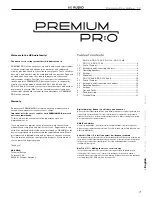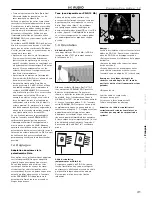
Premium Pr:o Active 1.7
8
1 PR:O 8 A, PR:O 10 XA,
PR:O 12 A, PR:O 12 MA,
PR:O 15 A, PR:O 15 XA
1.1 Control Features
Mains
220-240 V~
50-60 Hz
3 A max.
2
1
2
1
Music
Line
Mic
Speech
Gain
Input
Through
Power
Tone
Made in Germany
Serial No.
Green = On
Red = Limit/Error
Speaker Out
Min. imp. 8 Ohms
300 Watts
Caution:
Risk of
electric shock! Do not
open! Refer servicing
to qualified service
personnel.
Caution:
To reduce
the risk of electric
shock, grounding of
the center pin of this
plug must be
maintained.
Lea
ve enough space for proper ventila
tion!
Integrated Poweramp 600 Watts
2 A
1
3
4
5
6
7
8
9
2
1 Gain
This knob adjusts the input level.
2 Tone (not available on the
PR:O 12 MA)
The Tone knob lets you optimize your
active speaker cabinet for music or speech
applications. It uses a special filtering setup
that adapts frequency response to suit the
given requirements. Room acoustics vary as
does the cabinet’s position, so we recommend
you find the optimum position by piping in a
full-fledged music signal, using a microphone,
and twisting the knob. Turning it towards
„Speech“ boosts vocal signals, and turning
it towards „Music“ conjures a bigger, bolder
sonic image with more low end and less
midrange frequencies.
The Tone knob lets you tune the speaker
cabinet to suit music or public address
applications. Its special filtering circuit
adapts its frequency response to the given
requirements.
Note: Twisting the Tone knob counterclockwise
towards Music gradually attenuates a broad
midrange frequency band with a center
frequency of 1500 Hz (2500 Hz -PR:O 10 XA,
2600 Hz - PR:O 8 A). The maximum cut is
2 dB, achieved by setting the knob to the far
left position. At the same time, this adjustment
boosts bass frequencies in the range of 80
to 100 Hz in equal measure by up to 2 dB.
Twisting the Tone knob counterclockwise
towards Speech achieves the opposite effect,
boosting the midrange frequency band and
cutting bass frequencies accordingly by up to
2 dB.
A special corrective circuit compensates for
this EQ effect so that the perceived volume
level remains the same despite the change in
tone. Setting the knob to the center position
defeats the filter.
3 Mic/Line Switch (not on the
PR:O 12 MA)
When patching in a microphone, adjust the
input gain by setting the Line/Mic button to
Mic. This provides a 30-dB gain boost, thereby
optimizing the input for microphone signals.
4 Input
This electronically balanced XLR/ 1/4" combi
input accepts mixer signals (pin 1= ground,
2= +, 3= -).
5 Through
This parallel output patches the incoming line
signal through, for example, to other PREMIUM
PR:O active speakers or monitors.
6 Limiter Status LED
This dichromic LED indicates the signal level
and limiter status. Green means the signal level
is okay; red means the limiter has engaged and
is responding to high-volume signal peaks.
CAUTION! This is not a clip LED. It’s okay
if it lights up red briefly every now and
then; this merely indicates the RMS Limiter
is operating. If the signal LED remains
constantly in the red at signal peaks, check
the source signal’s input level and back off
the speaker’s Gain knob. A status LED that
lights up red continuously indicates there is
a fault in the speaker system.
7 Power Switch
This is the PREMIUM PR:O powered cabinet’s
on/off button. The signal LED lights up green
to indicate the cab is powered up.
Note: The Power button is embedded to
prevent unintentional actuation. When set
to POWER ON, the button sits almost flush
with the connector panel. This ensures it is
not engaged accidentally, yet remains readily
accessible.
8 Mains Input
Use the factory-included mains cord to
connect this socket to a wall outlet.
Note: All PREMIUM PR:O active speakers are
equipped with V-Lock mains sockets. If you
use a VOLEX locking mains cord or another
optionally available brand with the same
design, you can fix the mains cord in place
to prevent accidental disconnection.
9 Parallel Speaker Out
Use this Speakon NL4 output to connect
another passive PREMIUM PR:O enclosure or
another manufacturer’s passive cabinet.
Be sure to watch the impedance rating,
connecting no more than one enclosure with
an impedance no lower than 8 ohms. The
power amp delivers up to 300 watts to this
output.
1.2 Setting Up and
Connecting Cabinets
Connect cords routed from your mixer (monitor
out, line out, or a similar output) to the
balanced Input sockets using a cord equipped
with standard XLR microphone connectors.
Make sure the XLR connectors’ terminals are
configured as follows:
1= ground, 2= +, 3= -.
If you wish to connect a microphone directly
to the PREMIUM PR:O active cabinet
without going into a mixer first, plug it into
the balanced Input socket and set its input
sensitivity to Mic. Use a standard XLR
microphone cord to do this. Make sure the
XLR connectors’ terminals are configured as
follows:
1= ground, 2= +, 3= -.
1.3 Operating Speakers
• First make sure the powered cabinet is off.
CAUTION! Make sure the local mains
voltage matches the PREMIUM PR:O active
cabinet’s specified voltage. If you connect
the PREMIUM PR:O cab to the wrong mains
voltage, you may destroy its electronic
components.
• Back the Gain and Line/Mic knobs all the
way off, turning them counterclockwise as far
as they will go.
When connecting line signals, be sure to first
switch on all other connected components
first; that is, the connected mixer and signal
sources patched into it, such as keyboards,
instrument amps, effects and so forth.









































